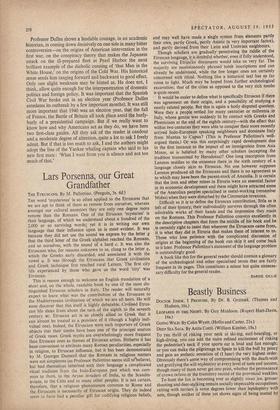Lars Porsenna, our Great Grandfather
THE ETRUSCANS. By M. Pallottino. (Penguin, 3s. 6d.) THE word 'mysterious' is so often applied to the Etruscans that we are apt to think of them as remote from ourselves, whereas amongst our cultural ancestors they are only one degree more remote than the Romans. One of the Etruscan 'mysteries' is their language, of which we understand about a hundred of the 2,000 or so surviving wordsi yet it is in writing our own language that their influence upon us is most1 evident. It was because they did not use the sound we express by the letter g that the third letter of the Greek alphabet reached the Romans, and so ourselves, with the sound of a hard c. It was also the Etruscans who, for reasons unknown to us, clung to the letter q, which the Greeks early discarded, and associated it with the vowel u. It was through the Etruscans that Greek civilisation and Greek technique first reached rural Latium. The first city life experienced by those who gave us the word 'city' was Etruscan.
This is reason enough to welcome an English translation of a short and, on the whole, readable book by one Of the most dis- tinguished Etruscan scholars in Italy. The reader will naturally expect to learn what was the contribution of the Etruscans to the Mediterranean civilisation of which we are all heirs. He will soon discover that this itself is highly debatable. Civilised Etrus- can life dates from about the turn of the eighth to the seventh century BC. Etruscan art is so closely allied to Greek that it can almost be treated as a province of it (though a' highly indi- vidual one). Indeed, the Etruscans were such importers of Greek objects that their tombs have been one of the principal sources of Greek vases. Greek myths are overwhelmingly more frequent than Etruscan ones as themes of Etruscan artists. Hitherto it has been convenient to attribute many Roman peculiarities, especially in religion, to Etruscan influence, but it has been demonstrated by M. Georges Dumezil that the Romans in religious matters were not simpletons (as Professor Pallottino seems still tebelieve), but had themselves inherited with their language a complicated ritual tradition from the Indo-European past which was com• mon to them, to the Aryan invaders of India, to the Scandin- avians, to the Celts and to many other peoples. It is not certain, therefore, that a religious phenomenon common to Rome and the Etruscans is necessarily of Etruscan origin. They do indeed seem to have had a peculiar gift for codifying religious beliefs,
and may well have made a single system from elements partly their own, partly Greek, partly Asiatic (a very important factor), and partly derived from their Latin and Umbrian neighbours.
Though scholars are gradually penetrating the riddle of the Etruscan language, it is doubtful whether, even if fully understood, the surviving Etruscan documents would take us very far. The majority are monotonously phrased toinb inscriptions and can already be understood, while the few longer ones are certainly concerned with ritual. Nothing like a historical text has so far come to light. Much may be hoped from further archwological excavation; that of the cities as opposed to the very rich tombs is quite recent.
It would be easier to define what is specifically Etruscan if there was agreement on their origin, and a possibility of studying ,a nearly related people. But this is again a hotly disputed question. Were they a people settled for many centuries or millennia ,ip Italy, whose genius was suddenly lit by contact with Greeks and Phoenicians at the end of the eighth century—with the effect that within two centuries they were able to conquer their more recently arrived Indo-European speaking neighbours and dominate Italy from Mantua to Capua? (This is Professor Pallottino's well- argued thesis.) Or was this surprisingly rapid development due in the first instance to the impact of an immigration from Asia Minor, as is believed by many other scholars (accepting the tradition transmitted by Herodotus)? One long inscription from Lemnos testifies to the existence there in the sixth century of a language closely akin to Etruscan. No one however supposes Lemnos produced all the Etruscans and there is no agreement as to which may have been the parent-stock of Anatolia. It is certain that the iron and other mines in Etruria were an essential factor in its economic development and these might have attracted some of the Anatolian peoples specialised in metal-working (remember Midas) when they were disturbed by the Cimmerian invasions.
Difficult as it is to define the Etruscan contribution, little as is left of their history, their individuality survives through the often admirable works of their hands and the impression they made on the Romans. This Professor Pallottino conveys excellently in the descriptive chapters that form the middle of his book and he is certainly right to insist that wherever the Etruscans came from, it is what they did in Etruria that makes them of interest to us. Those who lose patience with the complicated discussion of origins at the beginning of the book can skip it and come back to it later. Professor Pallottino's statement of the language problem is outstandingly good.
A book like this for the general reader should contain a glossary of the archwological and other specialised terms that are fairly frequent in its pages. This constitutes a minor but quite unneces- sary difficulty for the general reader.
DARSIE GILLIE


































 Previous page
Previous page